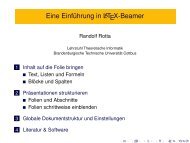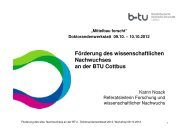Multilevel Graph Clustering with Density-Based Quality Measures
Multilevel Graph Clustering with Density-Based Quality Measures
Multilevel Graph Clustering with Density-Based Quality Measures
You also want an ePaper? Increase the reach of your titles
YUMPU automatically turns print PDFs into web optimized ePapers that Google loves.
3.3 Merge Selectorsvectors the eigenvectors are weighted <strong>with</strong> the square-root of their eigenvalues. Thusonly eigenvectors <strong>with</strong> a large eigenvalue have a significant influence. Moreover itis assumed that just using the positive eigenvalues suffices for the maximization.Thus all negative and weak positive eigenvalues are dropped from now on. Thisis controlled by the two parameters in the list below. The resulting approximatevertex vectors are denoted by ˜x v . An example of the relation between vertex and ˜x v, ˜X vcluster vectors is shown in Figure 3.8.spectral ratio Multiplied <strong>with</strong> the largest eigenvalue.accepted eigenvalues.Defines the lower limit forspectral max ev The maximal number of eigenvalues and -vectors to compute.Another important property besides the length of the vertex and cluster vectorsis their direction because in the optimum clustering the cluster vectors have to beorthogonal. This follows from the increase of vector length (and modularity) whenmerging two adjacent clusters <strong>with</strong> vectors which are separated by an angle below90 degree. Thus in m dimensions at most m + 1 clusters are representable. Hencein practice it is necessary to compute as many eigenvectors as expected clusters.Spectral Length and Length Difference From the spectral analysis of the previoussection follows that the modularity is improved by maximizing the length of eachcluster vector ˜X i = ∑ v∈C i ˜x v . The first idea was to select cluster pairs a, b <strong>with</strong> thelongest vector sum ||X a +X b || 2 . Hence this selection quality is called spectral length.spectral lengthOn second sight this selection quality is related to the modularity increase selectoras was already pointed out by Newman in [57]. The modularity increase in spectraldecomposition is the contribution of the new cluster ||X a + X b || 2 2 − ||Y a + Y b || 2 2 minusthe previous contribution of both clusters ||X a || 2 2 + ||X b|| 2 2 − ||Y a|| 2 2 − ||Y b|| 2 2 . Usingjust the positive eigenvalues results in the spectral length difference selector:2 ˜X T a ˜X b = || ˜X a + ˜X b || 2 2 − (|| ˜X a || 2 2 + || ˜X b || 2 2) (3.13)length differenceThe relation of both selection qualities to the modularity increase selector alsoinherits its disadvantages in the growth behavior. Looking at a long vector anadjacent long vector is ranked higher than all short vectors even when pointing intoa nearly orthogonal direction. Since the vector length roughly correlates <strong>with</strong> thevertex degree, high-degree vertices will be grouped together early leading to mergeerrors. Measuring the change in vector length instead reduces this domination butis nevertheless similar to the modularity increase selector. It is not directly obviouswhy dropping negative and weak eigenvalues should provide a better insight into theselection problem.Spectral Angle Instead of the misleading vector length the direction of the vectorscan be used. The spectral angle selector prefers pairs of adjacent clusters where thecluster vectors have the same direction, i.e. small angles. The angle is computedusing the cosine:41






